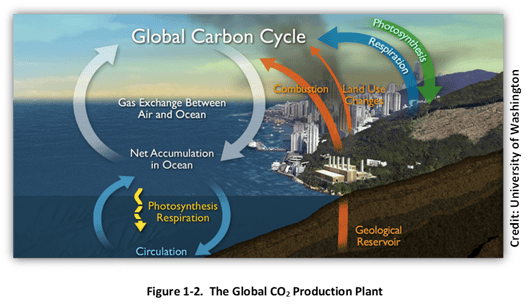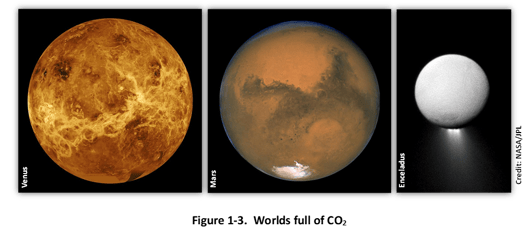Carbon Dioxide (CO2) is Universal
Abundant and Natural
 Carbon dioxide (CO2) is an abundant, natural, and renewable manufacturing resource. To begin with, you are a CO2 production plant. Shown in Figure 1-1, with each breathe of air, comprising about 78% Nitrogen (N2) and 21% Oxygen (O2), you expire a small amount of CO2 gas along with unused N2 gas, water vapor (H2O), and organic (carbon-based) vapors as metabolic by-products. Over the course of a day, you produce about 2.3 lbs. of gaseous CO2 [1]. This equates to filling a little over two 16 ounce water bottles with liquid carbon dioxide each and every day. Over a year, you fill nearly two 55 gallon drums. Over your lifetime, you will fill more than fifteen average-sized hot tubs – about 8,000 gallons of liquid CO2!
Carbon dioxide (CO2) is an abundant, natural, and renewable manufacturing resource. To begin with, you are a CO2 production plant. Shown in Figure 1-1, with each breathe of air, comprising about 78% Nitrogen (N2) and 21% Oxygen (O2), you expire a small amount of CO2 gas along with unused N2 gas, water vapor (H2O), and organic (carbon-based) vapors as metabolic by-products. Over the course of a day, you produce about 2.3 lbs. of gaseous CO2 [1]. This equates to filling a little over two 16 ounce water bottles with liquid carbon dioxide each and every day. Over a year, you fill nearly two 55 gallon drums. Over your lifetime, you will fill more than fifteen average-sized hot tubs – about 8,000 gallons of liquid CO2!
However, your biological output is only a small part of your overall CO2 production plant capacity. You generate even more CO2 while driving a car, cooking food, using a computer, or sitting in your hot tub drinking a cold beer while watching a football game, among many other human activities. The fact is most human activities require energy – and energy production, delivery, and utilization produces a lot of CO2 as a by-product. In addition, the company you work for produces even more CO2. Manufacturers and service providers alike need raw materials, office space, factories, trucks, equipment, and much more. All of this requires energy. As a result, a lot more CO2 is produced.
Moreover, the human CO2 production plant is just a miniscule part of an immense global CO2 production plant called the carbon cycle which produces, stores, and recycles CO2 through numerous mechanisms involving plants, animals, trees, bacteria, soil, atmosphere, oceans, and the Sun. For example, CO2 in combination with sunlight and water vapor is used by plants to grow (form carbon-based building blocks) and transpire O2 and water vapor back into the atmosphere as by-products, a process called photosynthesis. In fact, the main mechanism for enhancing and accelerating photosynthesis is the enrichment of the atmosphere with more “plant food” - CO2. In another example, CO2 is converted directly into O2 by the direct action of the Sun’s intense ultraviolet (UV) radiation entering the upper atmosphere, a process called photodissociation [2].
Earth’s carbon cycle is defined as the various biological, geological, and chemical processes by which carbon in various forms is stored and exchanged within the Earth’s entire ecosystem. Along with the nitrogen cycle and the water cycle, the carbon cycle comprises a sequence of interrelated processes that are key to making the Earth capable of sustaining life. As shown in Figure 1-2, the global carbon mass balance is the summation of all of the supplies and exchanges (inputs and outputs) of the various sources of carbon.

CO2 is an abundant, natural, renewable, and critically important source of carbon on Earth. However, CO2 may also be an abundant source of carbon in the universe. Evidence of this is found on our planetary neighbors [3]. Satellite images of Venus, Mars and Enceladus are shown in Figure 1-3. The atmosphere of Venus is 96.5% CO2 with an average temperature of 464 degrees C. Very different from Venus, Mars is a frozen world with an average temperature of -63 degrees C and has an atmosphere that is 95% CO2, 14x the atmospheric CO2 concentration as here on Earth. It is so cold on Mars that it snows CO2 and its polar regions accumulate CO2 ice similar to how Earth forms water-based glaciers at its poles.  Needless to say, the Martian climate is being studied in preparation for colonization in the future. In still another example, high speed geysers discovered at the south pole of Enceladus, a small moon of Saturn, have been determined by the Cassini spacecraft to be predominantly CO2 and water ice [4]. Most significantly, these discoveries point to the widespread existence of extraterrestrial carbon cycles based on CO2, and the possibility of carbon-based microbial life on other worlds.
Needless to say, the Martian climate is being studied in preparation for colonization in the future. In still another example, high speed geysers discovered at the south pole of Enceladus, a small moon of Saturn, have been determined by the Cassini spacecraft to be predominantly CO2 and water ice [4]. Most significantly, these discoveries point to the widespread existence of extraterrestrial carbon cycles based on CO2, and the possibility of carbon-based microbial life on other worlds.
Relevant to these discoveries, the latest CO2 spray cleaning technology discussed in this guidebook is being evaluated by NASA-JPL to decontaminate spacecraft and sampling equipment to prevent cross contamination of terrestrial Mars with extraterrestrial Earth carbon-based microbes, and without leaving traces of carbon-based cleaning agents other than already found in abundance on Mars and elsewhere in the solar system – CO2 [5].
References:
- 1-1. Human CO2 Emissions through Breathing, Carbon Dioxide Information Analysis Center: https://web.archive.org/web/20110410142100/http://cdiac.ornl.gov/pns/faq.html
- 1-2. Evidence for Direct Molecular Oxygen Production in CO2 Photodissociation, Science, October 2014: Vol. 346 no. 6205 pp 61-64
- 1-3. Planetary Factsheet: http://nssdc.gsfc.nasa.gov/planetary/factsheet
- 1-4. Cassini Observes the Active South Pole of Enceladus, Science, Vol. 311, 10 March 2006, pp 1391-1401
- 1-5. Particulate Removal using a CO2 Composite Spray Cleaning System, Nicole Chen et al., Jet Propulsion Laboratory, IEEE Aerospace Conference, Proceedings pp 3414-3426, March 2016




